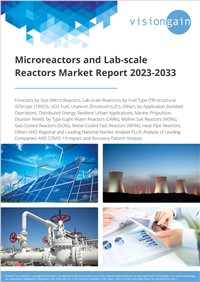The Microreactors and Lab-scale Reactors Market Report 2023-2033: This report will prove invaluable to leading firms striving for new revenue pockets if they wish to better understand the industry and its underlying dynamics. It will be useful for companies that would like to expand into different industries or to expand their existing operations in a new region.
Pioneering Eco-Friendly Solutions
The global shift towards sustainable and green chemistry practices is a major driving force behind the growth of the microreactors and lab-scale reactors market. As industries strive to reduce their environmental footprint and adhere to stringent regulations, microreactors and lab-scale reactors provide a versatile platform for developing eco-friendly processes. These compact reactors enable precise control over reaction conditions, minimizing waste and energy consumption. By facilitating efficient synthesis, optimization, and testing of chemical reactions on a smaller scale, they contribute to the development of cleaner and more sustainable processes across sectors such as pharmaceuticals, chemicals, and petrochemicals.
Accelerated Research and Development (R&D) Activities
Microreactors and lab-scale reactors play a pivotal role in expediting research and development activities. With their reduced reaction volumes and faster reaction kinetics, these reactors allow researchers to quickly explore various reaction conditions and screen multiple reaction pathways. This acceleration of R&D efforts enables the rapid development of new products, processes, and catalysts. Industries can efficiently test and validate hypotheses before scaling up to larger production volumes. This driver is particularly relevant in industries like pharmaceuticals and specialty chemicals, where timely innovation is critical to staying competitive and meeting market demands.
What Questions Should You Ask before Buying a Market Research Report?
- How is the microreactors and lab-scale reactors market evolving?
- What is driving and restraining the microreactors and lab-scale reactors market?
- How will each microreactors and lab-scale reactors submarket segment grow over the forecast period and how much revenue will these submarkets account for in 2033?
- How will the market shares for each microreactors and lab-scale reactors submarket develop from 2023 to 2033?
- What will be the main driver for the overall market from 2023 to 2033?
- Will leading microreactors and lab-scale reactors markets broadly follow the macroeconomic dynamics, or will individual national markets outperform others?
- How will the market shares of the national markets change by 2033 and which geographical region will lead the market in 2033?
- Who are the leading players and what are their prospects over the forecast period?
- What are the microreactors and lab-scale reactors projects for these leading companies?
- How will the industry evolve during the period between 2023 and 2033? What are the implications of microreactors and lab-scale reactors projects taking place now and over the next 10 years?
- Is there a greater need for product commercialisation to further scale the microreactors and lab-scale reactors market?
- Where is the microreactors and lab-scale reactors market heading and how can you ensure you are at the forefront of the market?
- What are the best investment options for new product and service lines?
- What are the key prospects for moving companies into a new growth path and C-suite?
You need to discover how this will impact the microreactors and lab-scale reactors market today, and over the next 10 years:
- Our 358-page report provides 123 tables and 155 charts/graphs exclusively to you.
- The report highlights key lucrative areas in the industry so you can target them – NOW.
- It contains in-depth analysis of global, regional and national sales and growth.
- It highlights for you the key successful trends, changes and revenue projections made by your competitors.
This report tells you TODAY how the microreactors and lab-scale reactors market will develop in the next 10 years, and in line with the variations in COVID-19 economic recession and bounce. This market is more critical now than at any point over the last 10 years.
Forecasts to 2033 and other analyses reveal commercial prospects
- In addition to revenue forecasting to 2033, our new study provides you with recent results, growth rates, and market shares.
- You will find original analyses, with business outlooks and developments.
- Discover qualitative analyses (including market dynamics, drivers, opportunities, restraints and challenges), cost structure, impact of rising microreactors and lab-scale reactors prices and recent developments.
This report includes data analysis and invaluable insight into how COVID-19 will affect the industry and your company. Four COVID-19 recovery patterns and their impact, namely, “V”, “L”, “W” and “U” are discussed in this report.
Segments Covered in the Report
Market Segment by Size
- Micro Reactors
- Lab-scale Reactors
Market Segment by Fuel Type
- TRi-structural ISOtropic (TRISO)
- UO2 fuel
- Uranium Zirconium (UZr)
- Other Fuel Type
Market Segment by Application
- Isolated Operations
- Distributed Energy
- Resilient Urban Applications
- Marine Propulsion
- Disaster Relief
Market Segment by Type
- Light-Water Reactors (LWRs)
- Molten Salt Reactors (MSRs)
- Gas-Cooled Reactors (GCRs)
- Metal-Cooled Fast Reactors (MFRs)
- Heat Pipe Reactors
- Other Type



